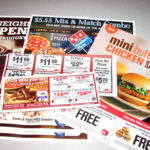
Shoppers these days aren’t using as many coupons as they used to. But that doesn’t mean we’re all resigned to paying full price. A new study says shoppers are still deal-seekers – they’re just seeking those deals differently.
“Deals are still important to consumers,” reads TABS Analytics’ Fifth Annual Food and Beverage Consumables Study. But “not all deals are created equal.”
According to a survey of 1,000 American shoppers, 31% reported using paper coupons. That’s down from 34% last year and way down from 45% in the first year of the survey in 2013. 39% consult the circular and shop the sales, down from 42% last year and far below 2013’s 50%.
Most survey respondents save money by shopping around, and choosing stores that offer the lowest prices. 46% visit multiple stores to get the best deals, and 63% shop at stores that offer everyday low prices.
Overall, “deal activity has stabilized after three years of steep declines, which resulted from frustrated shoppers who said in past surveys that they were unable to find deals,” the report reads.
Now those shoppers are getting deals without even having to work for them. The most popular way to save money – by shopping at stores that have low prices – is also the least demanding.
“EDLP (everyday low pricing) continues to be the preferred deal tactic for consumers,” the report declares. That “bodes well for the continued success of discount grocers, like ALDI and Lidl, which are expanding and gaining traction in the U.S.”
The no-frills grocer ALDI is in the midst of a plan to open 900 new stores and remodel hundreds more over the next five years, bringing its U.S. store count to 2,500. The similar, small-format German import Lidl has already opened a few dozen U.S. stores, and plans to open hundreds more in the coming years.
And neither of them accepts manufacturers’ coupons at all.
Despite that fact, TABS’ report suggests there’s no better time for ALDI and Lidl than now. It found that discount grocery stores had the largest gain in share of all food shopping trips. 5.5% of grocery shopping trips are now conducted at the likes of ALDI and Lidl, up from 3.9% last year. Walmart remains in first place, increasing its share from 15.2% to 16%. And as a group, grocers lost the most ground, down 1.7 percentage points to represent a combined 20.9% of all grocery shopping trips.
So only one in five grocery shopping trips is actually conducted in a grocery store. How times have changed.
But that’s not even the highlight of the study. “Perhaps one of the most important findings in this survey is the correlation between how much a heavy shopper buys and his or her propensity to also use various deal tactics,” the report reads. In other words, heavy deal shoppers are also heavy buyers. They account for 47% of all grocery sales.
So stores shouldn’t shun deal shoppers as cheapskates who are going to cost them money. On the contrary, TABS says, they should welcome such shoppers with open arms – and offer them more deals.
“Retailers have a strong opportunity here to improve sales by increasing the deals they offer, and targeting the consumers who shop at their locations the most,” the report concluded.
So coupons and circulars may be falling out of favor. But while the tactics may change – it seems saving money never goes out of style.










